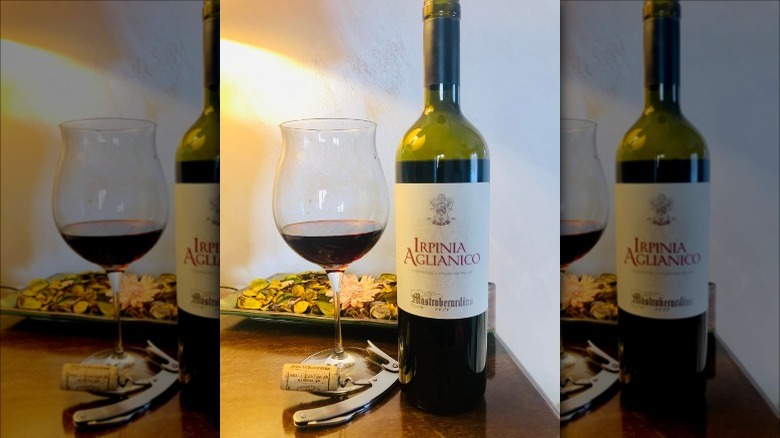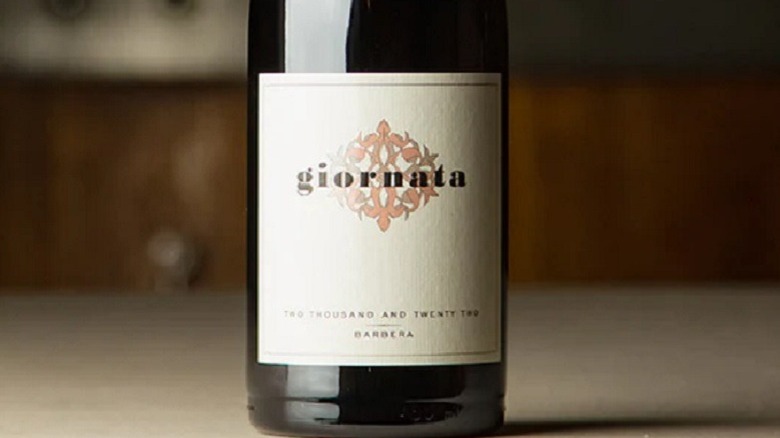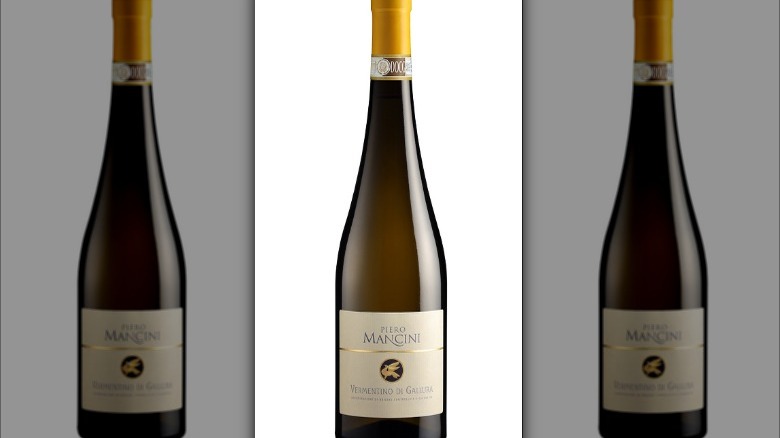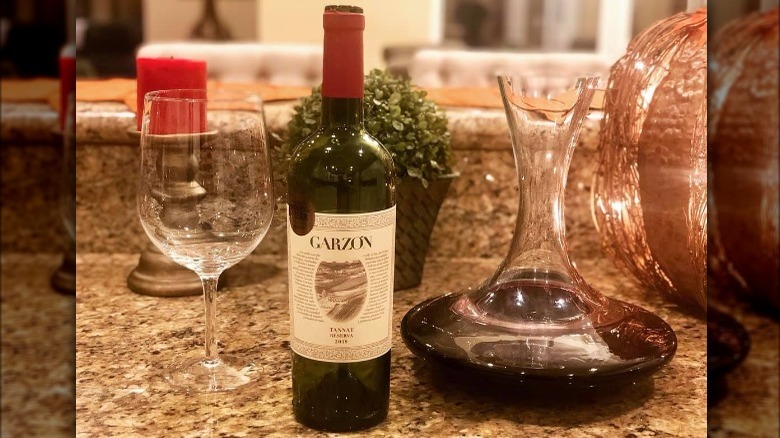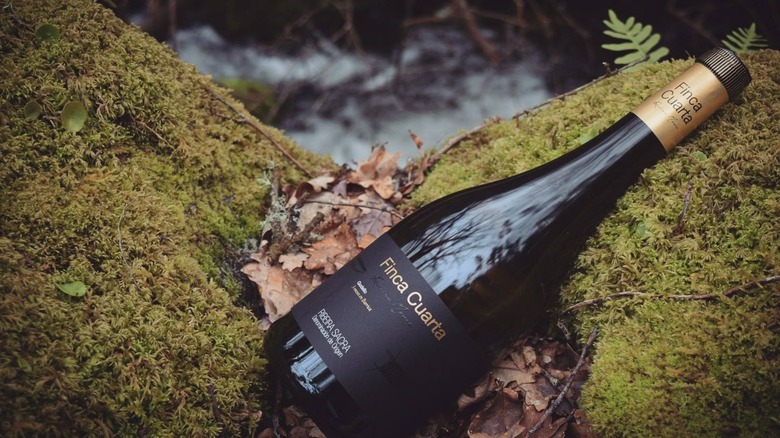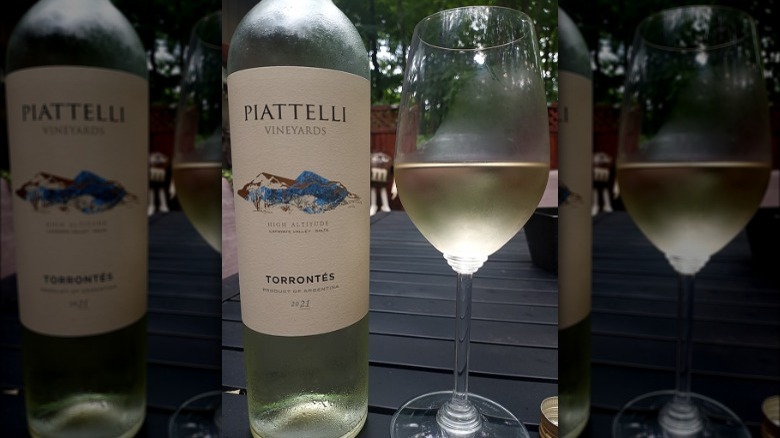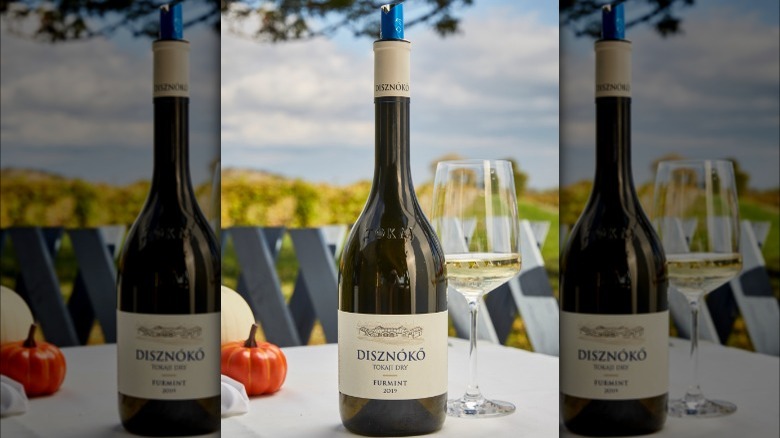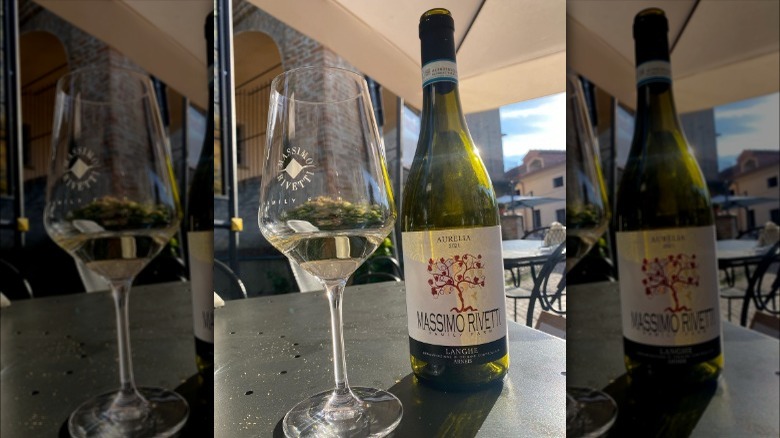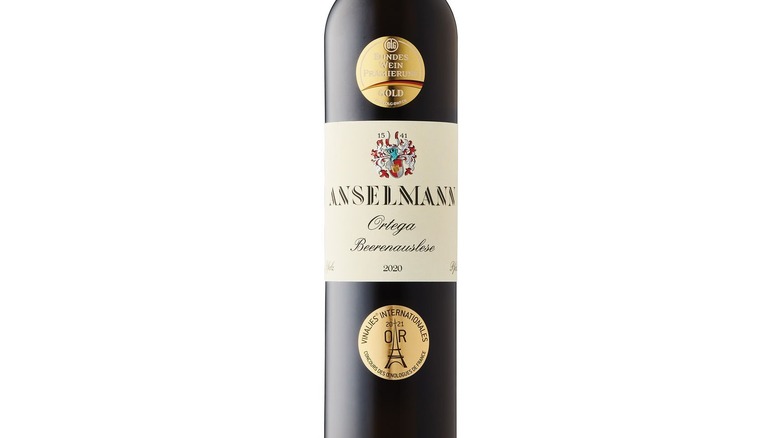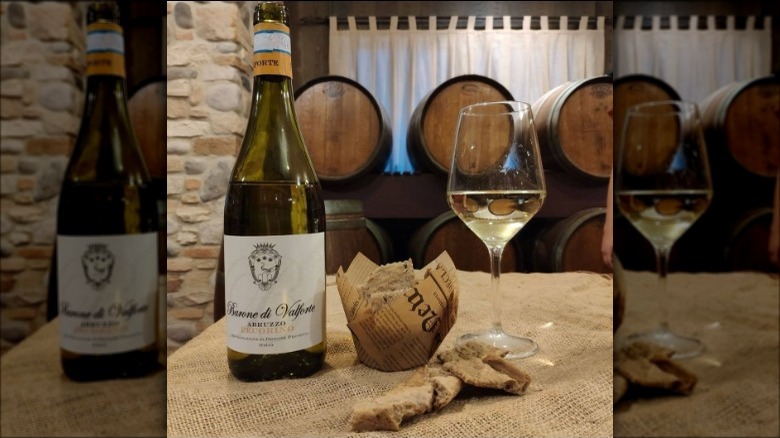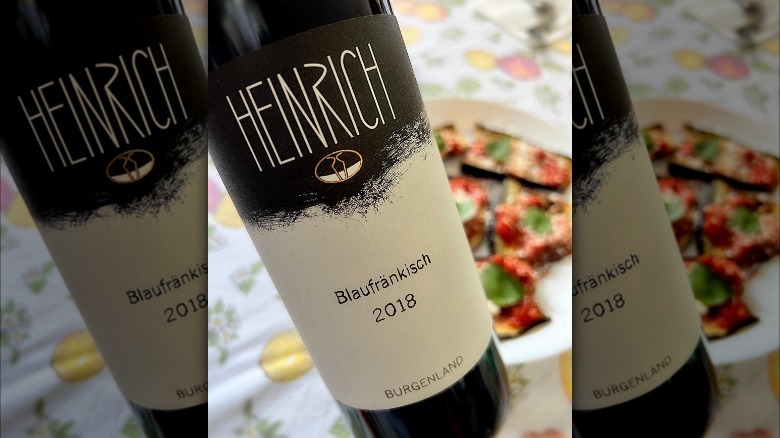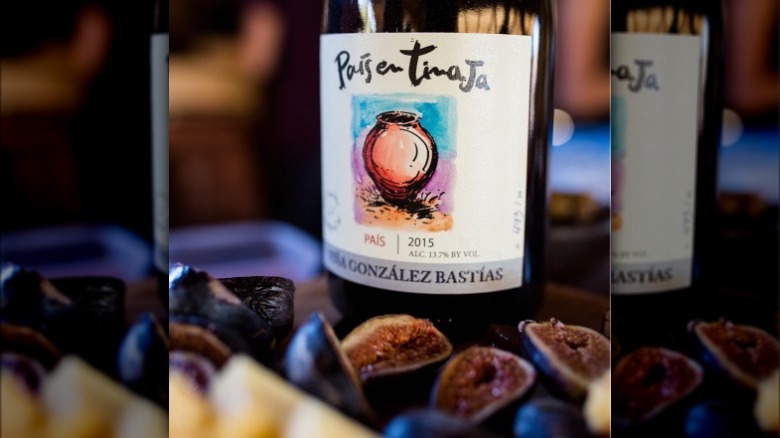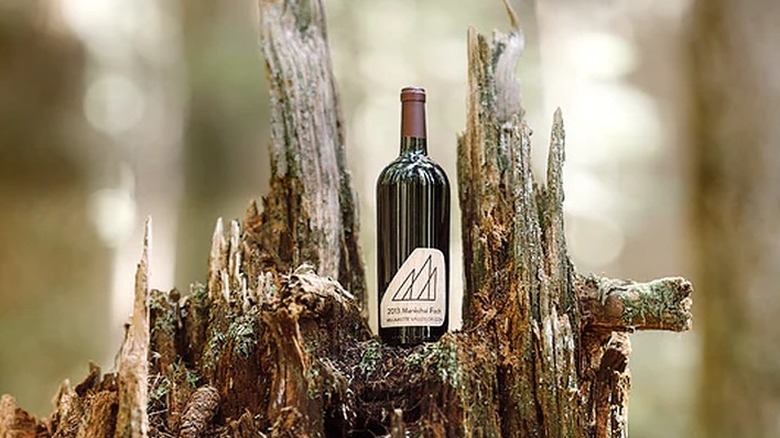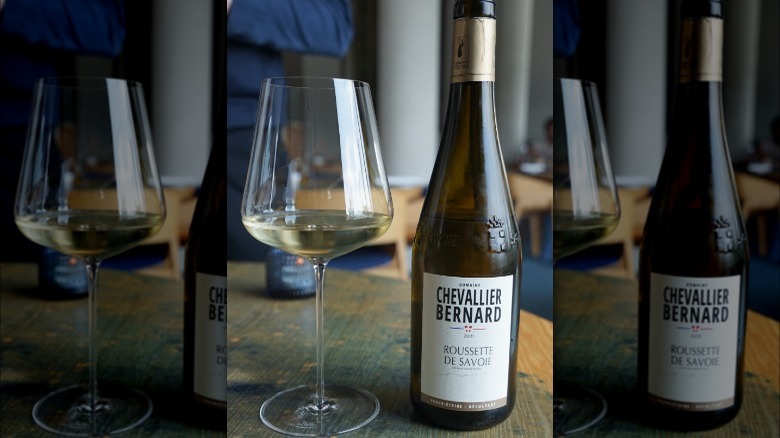14 Underrated Wine Varieties You Need To Try
Considering that 10,000 or so grape varieties grow worldwide, you might want to expand your repertoire beyond the usual suspects. Famed wine writer Jancis Robinson included just over 1,300 of them in her famed "Wine Grapes" compendium which is still only a mere fraction of what's out there. Nevertheless, the average consumer has only tasted a portion of these, often the same ones on repeat. It's not surprising, given the world of wine can be overwhelming, to say the least. With grapes originating all over, it's easy to lose sight of all the names, leaving you to sip on familiar grapes out of convenience.
Classic wines like cabernet sauvignon and pinot grigio take up a lot of space on the market, getting in the way of some more obscure varieties that deserve your attention. Thankfully, you don't have to look too far to find something different. Whereas some wine grapes grow in smaller quantities making them rarer, others are widespread but simply haven't been valued for their full worth. Either way, you'll want to pick up a bottle the next time you spot one of these underrated varieties.
1. Aglianico
Italy is revered for its red wines, but with so many indigenous varieties it's easy to miss out on some winners. Italian wine aficionados tend to know about this bold grape, but if you're among the people who are still in the dark about aglianico, this is your sign to make it your next purchase.
The dark-skinned variety may very well be one of Italy's oldest, and it seems to have preceded syrah, negroamaro, and teroldego. The Romans were drinking the stuff, but it was almost entirely eliminated by the phylloxera pest. The Campanian Mastroberardino family began making wine in the region shortly after its near decimation and assisted the grape's revival and eventual success. The hot climate is ideal for ripening aglianico, resulting in a grape that produces wines with a deep color, high acid, and notable tannins.
Try Irpinia aglianico by Mastroberardino for an authentic taste of Campania's native grape. The volcanic soils from nearby Vesuvius provide a bold backbone, yet this wine remains sophisticated and graceful thanks to a short maceration period and stainless steel fermentation, followed by 10 months of aging in oak and another six in the bottle. The result is intense with aromas of wild blackberry, black cherry, and a gamey spiciness that lights up the palate. Serve it with red or white meat or try it with earthy mushroom-based dishes.
2. Barbera
If you were only looking at the numbers, you might wonder why barbera is on this list. After all, it was the third top variety in Italy by acreage until recently. Grown in the Piedmont region, barbera has long been minimized next to its neighboring star variety nebbiolo. While too many bland and uninteresting wines have been made with it, its potential reaches far beyond these feeble renditions. There's a reason why it has been grown for 800 years and is increasingly being planted in hot regions such as California, Argentina, and Australia.
Although you'll find plenty of it in Piedmont, why not taste a bottle made closer to home? Giornata in Paso Robles offers a dazzling take with its barbera. This lighter-bodied wine is fresh, juicy, and the perfect combination of ripe fruit with bright acidity. A stainless-steel fermentation keeps the aromas vibrant and alive, with notes of rosemary, fennel, sour cherry, and white pepper. Enjoy it solo or serve it with a cheesy slice of pizza or a saucy pasta dish.
3. Vermentino/Rolle
If you've caught on that the wine world can be a little confusing at times, it won't surprise you that a number of grapes have multiple names. Known as vermentino in Italy and rolle in the South of France, this white wine variety is a seaside favorite. In Italy, it is primarily found on the islands of Sardinia and Corsica, as well as in Liguria, where it ranges from fruity and floral to a richer layered style.
Examples that display zesty herbal notes are comparable to sauvignon blanc wines with a softer touch. Meanwhile, in Provence, France, it is regularly included in the iconic rosés. Thanks to its capacity to tolerate heat and windy coastal conditions, vermentino is being planted successfully in places such as Australia.
Vermentino di Gallura DOCG is the star player among Sardinian versions, as you'll understand once you taste a bottle by Piero Mancini. Grown in granite soils, this wine exudes intensity and finesse. Stone fruit and tropical aromas mingle with floral notes, while a subtly bitter almond finish and medium body round it off. This pleasantly textured white wine pairs well with shellfish, fish, and poultry.
4. Tannat
If you've never heard of this grape, you may recognize the name's relation to the word tannin. Indeed, it tends to come with a hefty load of tannins that vary in intensity depending on its origin. Traditionally from Southwest France, tannat has since found far more success in Uruguay, becoming the country's leading variety and accounting for more than one-quarter of all plantings, according to South America Wine Guide. The country's coastal position provides an excellent balance of sunshine, heat, and cooling breezes that together ripen tannat to its optimal potential.
Though tannic, when grown in warm climates it displays rich fruit aromas to balance it out. If you're visiting Uruguay, a classic cut of beef will pair well with a glass of tannat. Health-conscious folks will be glad to know that it boasts exceptionally high polyphenol levels, the antioxidant compounds that may offer cardiovascular benefits.
Easily the most influential winery making tannat wine in Uruguay is Bodega Garzón. Its reserva tannat hints at its intensity from its deep color. Notes of red and dark fruits are present on the palate, with subtle spice that adds complexity. Oak aging in large casks smoothens out the grippy tannins, for a rich wine you'll want to serve with meat.
5. Mencía/Jaen
We're all for Spain's well-established Rioja wines, but the popular wine-producing country has plenty more to offer. Mencía originated in northwest Spain and is also grown in Portugal as jaen. Look for top examples from Ribeira Sacra, Bierzo, and Valdeorras in Spain, or in Dão, Portugal. Prior to some genetic testing, it was thought to be cabernet franc due to the overlapping earthy and bell pepper flavor profile. Standing proud as its own, mencía skirts the line between lighter-bodied reds and more complex styles, offering an element of rusticity contrasted by elegance.
Finca Cuarta mencía from old vines in the Ribeira Sacra region balances fresh acidity with intense aromas. Violets, red and dark fruits, and a hint of licorice are alive in every sip. Lovers of both fruity and earthy styles of red wine will enjoy this flavorful bottle as well as its excellent value. Serve it with red or white meat dishes, or pour it alongside a mushroom risotto to highlight the earthy aromas.
6. Torrontés
Just because a wine variety can grow somewhere isn't a reason to encourage it to do so. Argentine torrontés has its share of critics who've tasted bottles from Mendoza and vowed never to try it again. Considering the white grape actually consists of three subvarieties, a lot is lost in this simple rejection. Torrontés Riojano is generally agreed to be the best, and its main growing area is in the north of the country at high altitudes. The result is an aromatic grape that retains a vibrant palate. Its origins have been traced back to muscat, another notably perfumed variety.
Piattelli Vineyards torrontés is produced in the northern province of Salta in vineyards at almost 6,000 feet of altitude. Large swings in temperature between day and nighttime keep acidity high to offset the rich fragrant notes. Luscious fruit aromas of pineapple, peach, and orange blossoms explode in the mouth, while a subtle hint of lychee and orange zest round it out. Citrus elements keep it fresh, making this an excellent wine to pair with spicy cuisines.
7. Furmint
If you've savored Hungary's famous Tokaji Aszú dessert wines, you may very well have tasted furmint. Still, the grape's potential extends far beyond the decadently sweet spectrum. Dry furmint is in a league of its own, and you'll want to snag a bottle before too many people catch on. Outside of Hungary the grape also grows in Slovenia and Slovakia so you'll want to explore the different styles.
Part of what makes the variety suitable for dessert wines is its notable acidity, which translates into a fresh and zesty wine when vinified dry. Stone fruit and citrus are common aromas and a subtle minerality is a nod to the volcanic terroir. When aged in oak it takes on a creamier more rounded texture, whereas a stainless steel maturation retains its sharper qualities.
Disznókő Tokaji dry furmint is made in a lighter style, featuring a pleasant fruitiness in every sip. Lemon, stone fruit, and pear are present on the palate with a delicate fragrance and bright acidity. Drink it solo on a sunny patio or serve it with seafood — it may become your new favorite oyster pairing. It also goes down well with crunchy salads and simple poultry dishes.
8. Arneis
Italian wine lovers tend to place Piedmont's red wines on a pedestal. While we've already noted that barbera deserves to be up there with nebbiolo wines, the region's white grapes warrant some attention too. Arneis has been around for several hundred years and was once commonly blended in small proportions with nebbiolo to smoothen the tannins. It was even reduced to bait for pests to prevent them from destroying nebbiolo vines.
Although arneis is tricky to deal with in the vineyard, in optimal conditions it produces fuller-bodied white wines with ripe stone fruits and honeysuckle aromas enhanced by a streak of acidity. Try Massimo Rivetti's Langhe arneis Aurelia for a successful take on this finicky grape. Grown at altitude, the fruit retains acidity while maturing to its fullest potential. Floral notes mingle with stone fruit, guava, and a citrusy finish while mineral aromas stand out in the background. Enjoy it on its own or serve it with creamy seafood dishes like shellfish pasta or crabcakes.
9. Ortega
Ortega might not be internationally renowned at this point, however, it is proving its potential in a number of cool-climate regions around the world. Its above-average sugar levels make it a good candidate for cooler conditions where acidity reigns and fruit often does not get sufficient heat to fully ripen. Originally from Germany, the grape is now popular in England and wine-producing regions in Western and Eastern Canada. The variety was created by crossing two German white grapes, müller-thurgau and siegerrebe.
Ortega wines tend to be highly aromatic, with notes of flowers and stone fruit on the palate. A degree of sweetness is often present, but there are plenty of examples of dry ortega too. At the moment, the options in the U.S. are mostly limited to sweeter styles from Germany, as British and Canadian wine exports are relatively low.
Locally, Square Cloud Winery in Texas has been successful producing ortega wines. Familiarize yourself with the grape by trying a dessert style from Germany. Weingut Anselmann ortega beerenauslese is the perfect sweet wine to serve with fruity desserts or to enjoy one luscious sip at a time.
10. Pecorino
Not to be confused with the cheese of the same name, pecorino is a white wine grape from Italy's Le Marche and Abruzzo regions. That being said, the two make an excellent pairing, a union that may have led to the origin of its name. Pecorino offers nuanced aromas with a vivacious crisp edge that keeps it light. Though it is grown in smaller quantities than local reds and other regional white wines, most bottlings are produced with a high level of quality.
Barone di Valforte Abruzzo Pecorino DOP is a prime example of the grape from the Abruzzo region. Structured yet lively and elegant, this zesty white wine displays aromatic features with pear, citrus, and almond notes on the palate. Floral, mineral, and herbal elements shine through too, making this easy-to-drink wine delightfully complex. Enjoy it chilled by itself, with a hunk of cheese, or pair it with a variety of dishes for its palate-cleansing qualities. It'll fit right in with a light seafood dinner or contrasted with creamier preparations.
11. Blaufränkisch/Lemberger
Austrian wine has its fair share of devotees, but many of them stick to the two varieties with the most plantings: grüner veltliner and zweigelt. Blaufränkisch only makes up about 6% of vineyards, per Austrian Wine, so it tends to be a bit more limited on the market. Nevertheless, don't be intimidated by the long name — just trust us.
Producing lighter-bodied juicy red wines with a hint of spice, blaufränkisch exudes aromas of blue and red fruits. Elegant, structured, and fluctuating between weightier oak-aged styles and bright fresh ones, you'll want to source a bottle now. Outside of Austria, it's rare, though it's typically referred to as lemberger (yet one more name to remember).
Weingut Heinrich farms vineyards in accordance with organic and biodynamic principles and its blaufränkisch is a fine example of the grape's potential. A spicy herbaceous twist blends with red berry fruit notes in every smooth sip, and it's just as delicious as you would expect. Pair this wine with an assortment of dishes, from classic poultry roasts and spiced lamb preparations to oriental cuisine and braised stews.
12. País
Trends tend to reliably come around again after a hiatus, and the same can be said about certain grape varieties. The país grape from Chile (aka mission or criolla chica) was once grown extensively in North and South America. Introduced by none other than Christopher Columbus, the grape was successful across the continent. Unfortunately, it grew so well that it became synonymous with bland table wine for some time, quickly being discarded from the interest of fine wine drinkers.
Thankfully, a motivated group of winemakers has been rekindling país' fire in Chile. With the oldest vines dating over two centuries, this grape is simultaneously historic and trendy again. Vineyards are tended to with care to avoid overproduction, guaranteeing that pretty much any recent país wine from Chile you pick up will be good. The versatile grape can be made into light and juicy fruit-forward sippers, more elegant wines with floral notes and spice, and pleasantly spritzy sparkling wines.
Try González Bastías' País en Tinaja, aged in clay amphoras for a rustic yet smooth finish. Juicy plums and raspberry notes can be tasted, along with spices like cinnamon, turmeric, anise, and coriander. Hints of citrus peel and a vibrant acidity keep it fresh in the glass. Serve it solo as a conversation starter or paired with roast poultry, mushroom dishes, or grilled vegetables.
13. Marechal Foch
As climatic conditions continue to shift, wineries and consumers will become increasingly familiar with hybrid grapes. Bred by crossing two species of vine plants, these varieties are typically produced to withstand marginal zones of viticulture. Additionally, they often feature pest-resistant qualities that make them easier to farm. Nevertheless, considering hybrid grapes don't have the prestige of classic varieties, many wine drinkers are unaware of them or believe them to be inferior.
Well-made Marechal Foch is juicy with intense dark berry fruit notes and a hint of smokiness. It can be vinified in lighter styles to highlight the fruity aromas or aged in oak for extra depth and complexity. The U.S. and Canada produce the majority of wines from this variety on the market, but chances are the area under vine will expand over the next several years as vintners seek out new options.
Backstay Wine Co. in the Willamette Valley makes a tasty version aged in American oak. Dark fruit aromas mingle with notes of leather, chocolate, and spice in this bold wine. The balanced acidity makes it easy to pair with food; serve it with grilled salmon, roast chicken, or steak. Thanks to its rounded fruit notes it can even fare well alongside a chocolate dessert.
14. Altesse/Roussette de Savoie
France is by no means an underrated wine region. Still, there are numerous viticultural areas around the country that don't get as much love as the primary main players. The Alpine region of Savoie is slowly getting more attention from wine aficionados, and it's entirely warranted. The mountainous terrain offers the perfect conditions for the altesse variety (aka roussette de Savoie), leading to a rich aromatic profile that's brimming with flavor.
Thanks to the altitude, the grape retains plenty of acidity, keeping it fresh and vibrant on the palate. Try a bottle by Domaine Chevallier Bernard, a local producer who takes great care in teasing out the subtle nuances of the variety. Honeyed aromas dance with spicy floral notes in the glass, for a luscious taste that leaves you wanting more. Serve it with hearty cheese dishes to cut right through the fat, pour it to accompany a coconut-based curry, or enjoy it with a creamy white fish dish.

